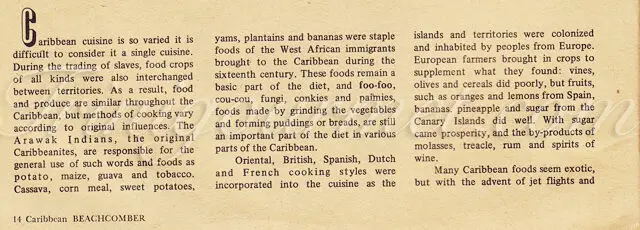Caribbean Beachcomber July/August 1969 – Caribbean Food Overview

Transcription:
Caribbean cuisine is so varied it is difficult to consider it a single cuisine. During the trading of slaves, food crops of all kinds were also interchanged between territories. As. a result, food and produce are similar throughout the Caribbean, but methods of cooking vary according to original influences. The Arawak Indians, the original Caribbeanites, are responsible for ‘the general use of such words and foods as potato, maize, guava and tobacco. Cassava, corn meal, sweet potatoes, yams, plantains and bananas were staple foods of the West African immigrants brought to the Caribbean during the sixteenth century. These foods remain a basic part of the diet, and foo-foo., cou-cou, fungi, conkies and paimies, foods made by grinding the vegetables and forming puddings or breads, are still an important part of the diet in various parts of the Caribbean.
Oriental, British, Spanish, Dutch and French cooking styles were incorporated into the cuisine as the islands and territories were colonized and inhabited by peoples from Europe. European farmers brought in crops to supplement what they found: vines, olives and cereals did poorly, but fruits, such as oranges and lemons from Spain, bananas, pineapple and sugar from the Canary Islands did well. With sugar came prosperity, and the by-products of molasses, treacle, rum and spirits of wine.
Many Caribbean foods seem exotic, but with the advent of .jet flights and modern packaging methods more and more new foods are being introduced to the world’s marketplaces. If breadfruit vichyssoise seems overly exotic today, look forward to tomorrow when it may appear among the other ‘provisions’ (starchy vegetables) at your friendly grocer’s. Meanwhile, Caribbeanites are plucking the fruit from the trees or buying it at the marketplace.
The following recipes give a brief sampling of the range of cuisine available today iin the Caribbean. Most of the ingredients listed are available in season in most parts of the world, although it may take some searching in specialty food stores. It’s worth the effort – Caribbean cooking has gleaned the best of the world’s cooking styles to create a unique and varied cuisine worthy of the most sophisticated palate.
Many readers of this issue of Caribbean Beachcomber would have heard the sounds of the Mighty Sparrow’s Sa Sa Yea that year in the travels within our region.
